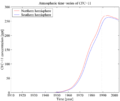| |||
| Names | |||
|---|---|---|---|
| Preferred IUPAC name Trichloro(fluoro)methane | |||
| Other names Trichlorofluoromethane Fluorotrichloromethane Fluorochloroform Freon 11 CFC 11 R 11 Arcton 9 Freon 11A Freon 11B Freon HE Freon MF | |||
| Identifiers | |||
3D model (JSmol) | |||
| ChEBI | |||
| ChEMBL | |||
| ChemSpider | |||
| ECHA InfoCard | 100.000.812 | ||
| EC Number |
| ||
PubChem CID | |||
| RTECS number |
| ||
| UNII | |||
CompTox Dashboard (EPA) | |||
| |||
| |||
| Properties | |||
| CCl3F | |||
| Molar mass | 137.36 g·mol−1 | ||
| Appearance | Colorless liquid/gas | ||
| Odor | nearly odorless [1] | ||
| Density | 1.494 g/cm3 | ||
| Melting point | −110.48 °C (−166.86 °F; 162.67 K) | ||
| Boiling point | 23.77 °C (74.79 °F; 296.92 K) | ||
| 1.1 g/L (at 20 °C) | |||
| log P | 2.53 | ||
| Vapor pressure | 89 kPa at 20 °C 131 kPa at 30 °C | ||
| Thermal conductivity | 0.0079 W m−1 K−1 (gas at 300 K, ignoring pressure dependence) [2] [ verification needed ] | ||
| Hazards | |||
| GHS labelling: [3] | |||
 | |||
| Warning | |||
| H420 | |||
| P502 | |||
| Flash point | Non-flammable | ||
| Lethal dose or concentration (LD, LC): | |||
LCLo (lowest published) | 26,200 ppm (rat, 4 hr) 100,000 ppm (rat, 20 min) 100,000 ppm (rat, 2 hr) [4] | ||
| NIOSH (US health exposure limits): | |||
PEL (Permissible) | TWA 1000 ppm (5600 mg/m3) [1] | ||
REL (Recommended) | C 1000 ppm (5600 mg/m3) [1] | ||
IDLH (Immediate danger) | 2000 ppm [1] | ||
| Safety data sheet (SDS) | ICSC 0047 | ||
| Supplementary data page | |||
| Trichlorofluoromethane (data page) | |||
Except where otherwise noted, data are given for materials in their standard state (at 25 °C [77 °F], 100 kPa). | |||
Trichlorofluoromethane, also called freon-11, CFC-11, or R-11, is a chlorofluorocarbon (CFC). It is a colorless, faintly ethereal, and sweetish-smelling liquid that boils around room temperature. [5] CFC-11 is a Class 1 ozone-depleting substance which damages Earth's protective stratospheric ozone layer. [6] R-11 is not flammable at ambient temperature and pressure but it can become very combustible if heated and ignited by a strong ignition source.






